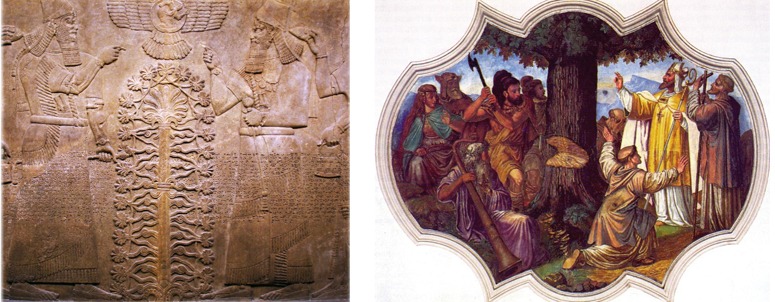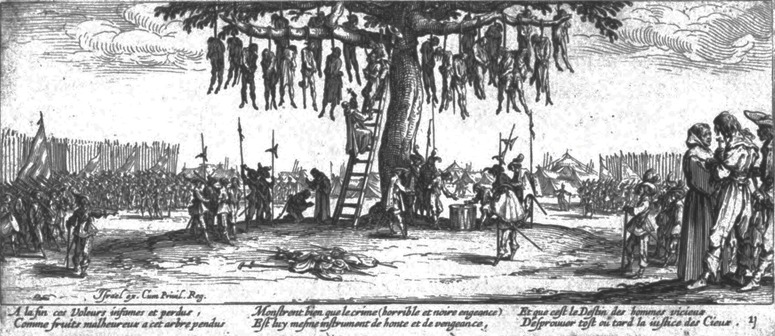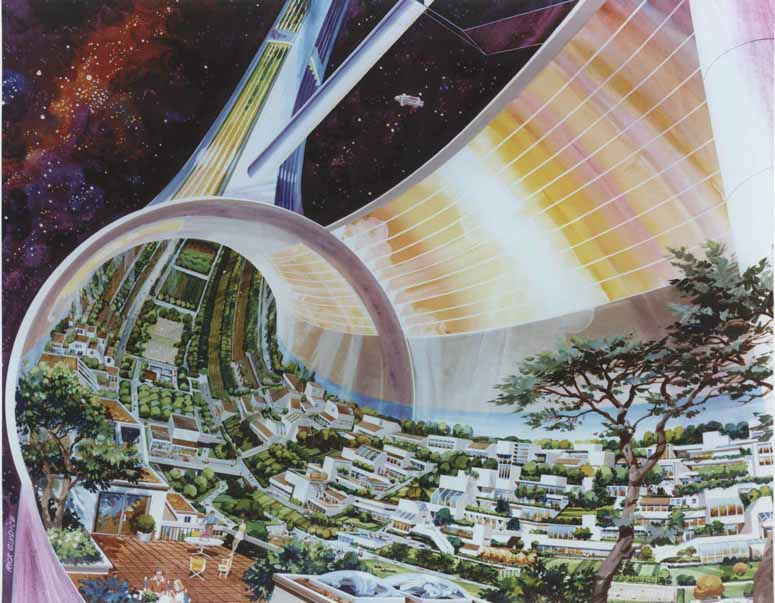 Thank you to Jack Varga (on Larch-L) for drawing attention to Nasa’s ideas on space colonies (see explanation and examples). They remind me of Sarah Eberle’s built example at the 2007 Chelsea Flower Show. But the Nasa examples are oddly suburban, as if humans would invest in travelling the universe to enjoy the delights of a modernist Levittown at high densities. Why would they need roofs if living in tubes? To protect from artificial rain? But it is probably correct that humans would soon tire of inter-galactic marvels and gaze instead at what the neighbours are up to – and that interest would help sustain tube life. It might in fact be a better idea to dispatch a spatter of tiny rockets containing only DNA, and this might be how life came to Planet Earth 3.5 billion years ago. My plea to Nasa is to send un-manned observatories into deep space – not humans.
Thank you to Jack Varga (on Larch-L) for drawing attention to Nasa’s ideas on space colonies (see explanation and examples). They remind me of Sarah Eberle’s built example at the 2007 Chelsea Flower Show. But the Nasa examples are oddly suburban, as if humans would invest in travelling the universe to enjoy the delights of a modernist Levittown at high densities. Why would they need roofs if living in tubes? To protect from artificial rain? But it is probably correct that humans would soon tire of inter-galactic marvels and gaze instead at what the neighbours are up to – and that interest would help sustain tube life. It might in fact be a better idea to dispatch a spatter of tiny rockets containing only DNA, and this might be how life came to Planet Earth 3.5 billion years ago. My plea to Nasa is to send un-manned observatories into deep space – not humans.
Category Archives: Sustainable design
The Easter Island Path to Perdition could show where humanity is heading
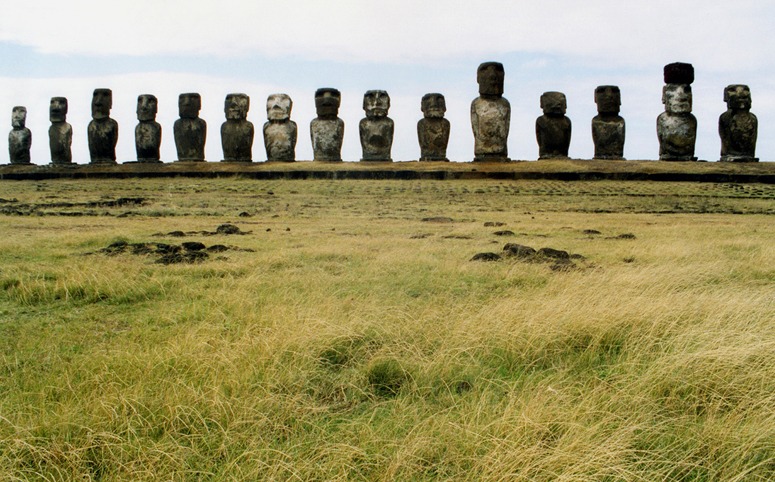 Following the below comments on Attitudes to life, death and trees in western culture and ‘civilization’, I thank Anoldent, for his photograph and his account of the Fifteen Moai on Easter Island: ‘Moai were status symbols. The more you had and the bigger they were, the greater your village’s status. Unfortunately, moving them around the island required many trees, and when the last trees were cut on the once heavily forested island, the topsoil blew away, the islanders could no longer build fishing boats, or even escape the ensuing famine. Wars erupted and the culture collapsed. An environmental cautionary tale. The island is still largely treeless.’ On a larger scale, too many humans think this way: ‘the more you have the better you are’: more rooms, more people, more buildings, more cars, more economic growth. But for humans who inhabit an island or a planet, aiming for more may result in less. Let’s call it ‘the Easter Island Path to Perdition’, and let’s be sufficiently optimistic to believe that the ‘civilization’ of cities will be replaced by a sophisticated landscape urbanism.
Following the below comments on Attitudes to life, death and trees in western culture and ‘civilization’, I thank Anoldent, for his photograph and his account of the Fifteen Moai on Easter Island: ‘Moai were status symbols. The more you had and the bigger they were, the greater your village’s status. Unfortunately, moving them around the island required many trees, and when the last trees were cut on the once heavily forested island, the topsoil blew away, the islanders could no longer build fishing boats, or even escape the ensuing famine. Wars erupted and the culture collapsed. An environmental cautionary tale. The island is still largely treeless.’ On a larger scale, too many humans think this way: ‘the more you have the better you are’: more rooms, more people, more buildings, more cars, more economic growth. But for humans who inhabit an island or a planet, aiming for more may result in less. Let’s call it ‘the Easter Island Path to Perdition’, and let’s be sufficiently optimistic to believe that the ‘civilization’ of cities will be replaced by a sophisticated landscape urbanism.
Attitudes to life, death and trees in western culture and 'civilization'
The illustrations show a Tree of Life (above left) in ancient West Asia, the felling of a Sacred Tree by St Boniface (Thor’s Oak, above right) and a Hanging Tree during the 30 Years War (below).
What do the illustrations tell us about changing attitudes to trees in western civilization? Here are some possibilities:
- the ancients saw trees (and forests) as symbols of the natural forces which control the world
- the early Church regarded tree-worship as idolatrous, because there is only one true God
- both trees and people were destroyed in the religious wars of the seventeenth century
In clearing and ‘managing’ what is left of the world’s forest cover we may be marching in the path of the Easter Islanders. At present, the most densely wooded countries are Finland (86% of the total land area), Sweden (57%) and Austria (47% ). Australia, suprisingly, has 20.1% forest cover. The European countries with the least forest are Ireland, with 8% of the land as forested and the United Kingdom with 11%.
Gardening on the roof, don't pass on the past….
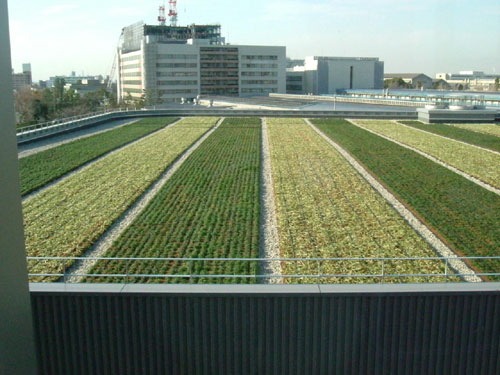 What can the past teach us about gardening in the present?
What can the past teach us about gardening in the present?
Undoubtably our ancestors were more agriculturally minded and more in tune with the rythmn of nature than we are today. The urban environments in which many of us live are climate modified, we buy our food from the supermarket and we heat and cool our living spaces.
Perhaps by revisiting previous garden traditions – such as the zen tradition in Japanese gardens – we can begin to imagine a variety of ways of utilising our urban roof spaces for a variety of purposes.
The project to document Middle Eastern garden traditions is likely to provide a valuable source of inspiration for the future as well as potentially preserving and enhancing our knowledge of the past. Don’t skip the drawings.
The art of sketching and drawing can itself through film and projection techniques transform the urban landscape and create a virtual landscape….and a new way of thinking about ‘green’ surfaces.
A book for the landscape architect to die for is Sketch Landscape. There are many ways of communicating ideas, and this book has 500 sketches and scribbles by some of the best.
How green is my garage?
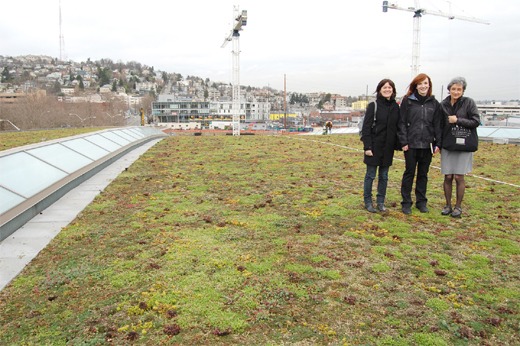 Bill Gates is famous not only for revolutionising communications but also for being the proud owner of the largest green roof garage in Seattle.
Bill Gates is famous not only for revolutionising communications but also for being the proud owner of the largest green roof garage in Seattle.
Maserati recently ran a garage design competition…and entries included not only green garages…but an insanely cool garage that is everything about setting and concept (if just a little light on resolution).
The winning entry shown on this youtube clip is car as ‘art’ and perhaps might be a useful way of thinking ‘green garage’ for Lace Hill.
Is this the landscape of future architecture?
 Should one call this architecture or landscape architecture or neither or both? It is a competition entry for 2010 Competition Entry for International Business Center with an Intercontinental Hotel in Yerevan. The designer explains: ‘Instead of a towering Iconic image, disconnected from historic, horizontal Yerevan, Lace Hill stitches the adjacent city and landscape together to support a holistic, ultra-green lifestyle, somewhere between rural hillside living and dense cultured urbanity’. The images are good but, if I were one of the judges, I would want to see some cross-sections and floor plans before awarding a prize.
Should one call this architecture or landscape architecture or neither or both? It is a competition entry for 2010 Competition Entry for International Business Center with an Intercontinental Hotel in Yerevan. The designer explains: ‘Instead of a towering Iconic image, disconnected from historic, horizontal Yerevan, Lace Hill stitches the adjacent city and landscape together to support a holistic, ultra-green lifestyle, somewhere between rural hillside living and dense cultured urbanity’. The images are good but, if I were one of the judges, I would want to see some cross-sections and floor plans before awarding a prize.
image courtesy Forrest Fulton

